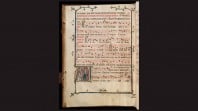Medieval manuscripts
'Manuscript' means 'written by hand' in Latin (manu, 'by hand', and scriptus, 'written'). The word describes any text that is produced without mechanical aid, primarily those inscribed with a pen or brush on papyrus, paper or vellum (prepared animal skin) using ink and other pigments. Technically, it could also describe clay tablets and Roman wax tablets, formats that preceded both the scroll and the codex, on which marks were made using a stylus.
Over the millennia, and continuing into the modern era, cultures all around the world have produced manuscripts. The Library holds medieval and early-modern (pre-1900) manuscripts from Afghanistan, England, Ethiopia, France, Germany, India, Indonesia, Iran, Italy, the Middle East, the Netherlands and South-East Asia, many of which are digitised.
Because of the manuscripts' fragility and preservation needs, those wishing to use them must discuss their needs and possible alternatives (including digital and physical facsimiles) with Library staff.
European manuscripts
The Library's collection of 24 illuminated European manuscripts are digitised and available to view and download in high-resolution image files. These manuscripts were acquired between 1901 and 1949, many with funds from the Felton Bequest. They were included in the Library's 2008 Medieval imagination exhibition, and some can always be viewed in the annually refreshed World of the book exhibition.
The digital facsimiles (which include the holdings of the Art Gallery of Ballarat) are the outcome of an Australian Research Council Linkage Grant (2010–13), Medieval and Renaissance manuscripts in Australia: Researching and relating Australia's manuscript holdings to new technologies and new readers, in which this Library was a partner. Led by Professor emeritus Margaret Manion AO (University of Melbourne), Professor Bernard Muir (University of Melbourne), Dr Toby Burrows (University of Western Australia) and Shane Carmody (State Library Victoria), the project also contributed detailed scholarly entries (with bibliographies) for each of the Library's illuminated manuscripts, which are accessible through the catalogue records.


















